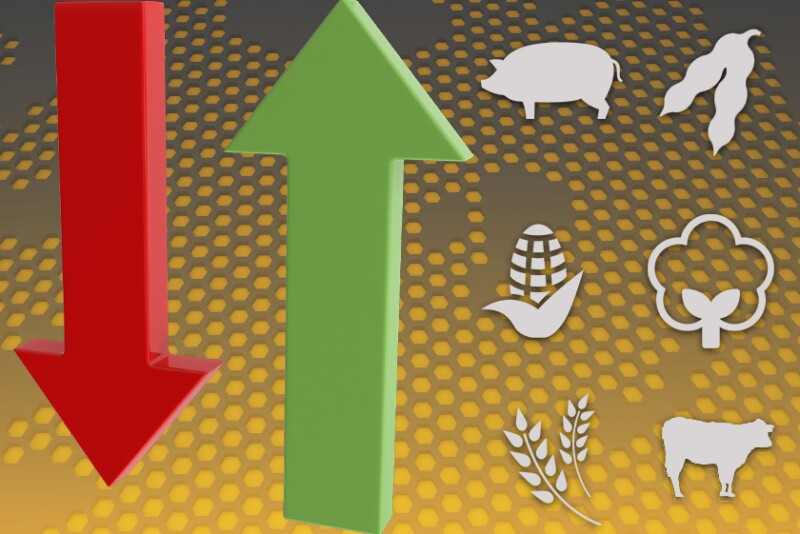GRAIN CALLS
Corn: 2 to 4 cents higher.
Soybeans: 13 to 15 cents higher.
Wheat: 4 to 7 cents lower.
GENERAL COMMENTS: Corn futures rose modestly overnight following a larger-than-expected decline in USDA’s weekly crop condition ratings. Soybean futures gained slightly over 1%, while winter wheat futures dropped. Malaysian palm oil futures were slightly lower amid reports of higher August production estimates, while Nymex crude futures were up over 1%, extending yesterday’s rally from three-month lows. The U.S. dollar index is holding near unchanged this morning.
USDA reported two daily export sales this morning. China bought 132,000 MT of U.S. soybeans for 2021-22. Mexico bought 123,500 MT of U.S. corn for 2021-22 delivery.
Crop Consultant Michael Cordonnier maintained his U.S. corn yield estimate of 175.5 bu. per acre and his bias is neutral to lower. “Weekend rains favored North Dakota, Minnesota and parts of central Iowa and there are more rains in the forecast,” he said in a report today. “These rains will help to stop the deterioration of the crop, but they probably came too late to add back any yield to the corn,” adding that they should help stabilize the crop in drier areas.
Cordonnier also maintained his soybean yield estimate of 50 bu. per acre and his bias is neutral to slightly lower. Recent rains “may add a little yield, especially in Iowa and southern Minnesota,” but moisture likely came too late to have a significant impact on yield in the Dakotas, where plants are already turning yellow.
The National Oceanic and Atmospheric Association recently raised the odds for a second consecutive La Nina for the South American summer to 70%. La Nina typically results in below-normal rainfall for southern Brazil and northern Argentina, and both regions are still experiencing one of their driest periods in 70 years. “Continued dryness from a resurgent La Nina could be devastating,” Cordonnier said in his report.
Difficult conditions in Germany hurt soft wheat yields, while mild temperatures and adequate water supply led to an improved yield outlook for summer crops in other parts of western and north-central Europe, European crop monitor MARS said on Monday, according to a Reuters report. The average soft wheat yield in this year’s EU harvest is expected to reach 5.98 metric tons (MT) per hectare (t/ha), down from a projected yield of 6.05 t/ha in July, the EU’s crop monitoring service said.
CORN: USDA late yesterday reported the U.S. corn crop in 60% “good” or “excellent” condition at the start of this week, down from 62% a week ago and at the low end of expectations. When USDA’s weekly condition ratings are plugged into the weighted Pro Farmer Crop Condition Index (CCI; 0 to 500-point scale, with 500 representing perfect), the corn crop dropped 4.8 points to 355.1 points, 12.2 points below the five-year average. Chart levels to watch include yesterday’s low at $5.32 1/2, the lowest intraday price since $5.27 1/2 on July 13.
SOYBEANS: USDA reported the U.S. soybean crop in 56% “good” to “excellent” condition at the start of this week, down from 57% a week ago and in-line with trade expectations. On our CCI, the soybean crop declined 2.5 points to 347.1 points, 13 points below for the five-year average. November soybeans overnight held within last Friday’s ranges, with chart levels to watch including $12.77 1/4, Friday’s low.
WHEAT: Overnight, December HRW futures fell to $7.08 1/2, edging below last week’s low of $7.09 and matching the intraday low on Aug. 9. December SRW was holding above last Friday’s low. The U.S. spring wheat crop was 77% harvested at the start of this week, up from 58% the previous week, USDA reported yesterday. That’s higher than trade expectations of about 74%.
LIVESTOCK CALLS
CATTLE: Steady-higher.
HOGS: Steady-weaker.
CATTLE: Futures may extend yesterday’s rally, which sent nearby live cattle to a 17-month high, behind a soaring beef market. Choice beef values rose $2.97 yesterday to $348.03, the highest since the pandemic-driven spike in May 2020. Product market gains have far outpaced those of the cash market. Live steers in five top feedlot regions yesterday averaged $125.47, matching last week’s average. Bullish sentiment was fueled by a larger-than-expected decline in USDA’s estimate for July feedlot placements. USDA’s Cold Storage Report yesterday afternoon showed U.S. beef supplies as of July 31 at 401.3 million lbs., down from 401.5 million a month earlier and down 8.8% from last year.
HOGS: Futures may face pressure from eroding chart patterns and the wholesale pork market’s slump to two-month lows. Carcass cutout values tumbled $6 yesterday to $113.26, the lowest since June 25, a USDA report showed. The decline was led by drops of over $12 in primal hams and nearly $16 in primal bellies. Movement was about 336 loads. Cash hogs on a national direct basis fell $3.72 to $92.68. Also yesterday, USDA’s monthly Cold Storage Report showed U.S. total pork supplies as of July 31 at 443.1 million lbs., up slightly from a month earlier but down 3.8% from the same date in 2020. Belly supplies, at 27.7 million lbs., were down 35% from the end of July a year earlier. By contrast, U.S. pork stocks in July decreased by an average of 1.8 million lbs. during the five previous years.

